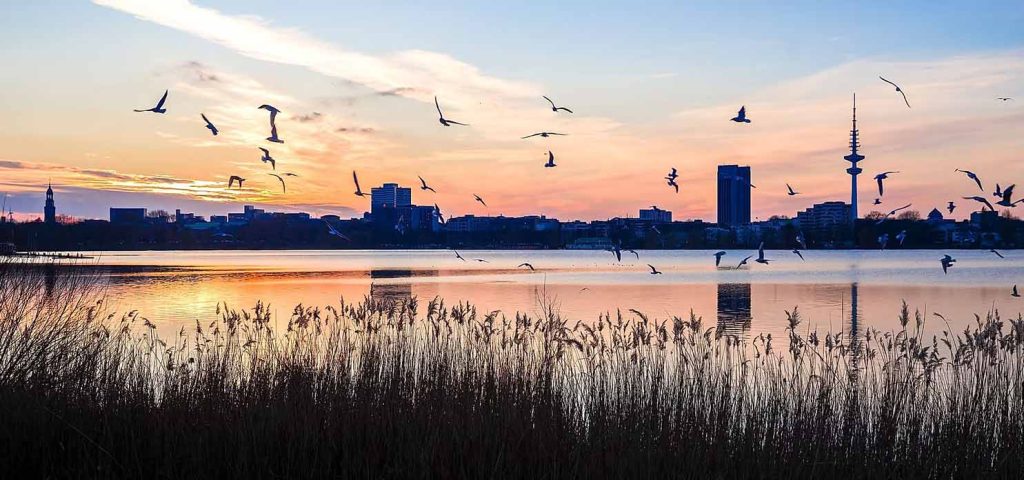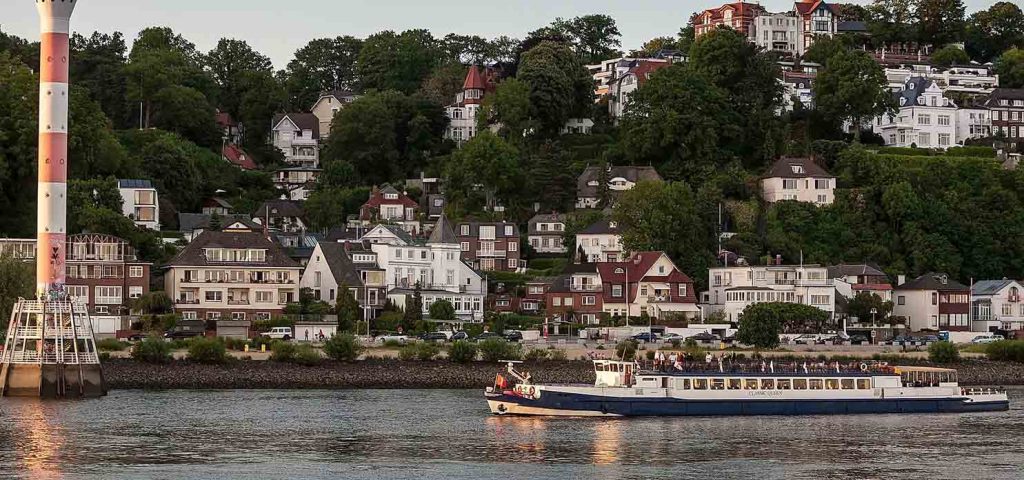At six in the morning, as the first rays of sunlight filtered through the window, a soft golden glow stirred me awake. Standing on my hotel balcony overlooking the quietly flowing Elbe River, the city seemed still lost in dreams. The river shimmered gently, and occasionally a cargo ship drifted by, leaving ripples in its wake. Far off, the cranes in the port resembled dormant giants in the morning mist, patiently awaiting their awakening. It was my first day in Hamburg, and this moment marked the beginning of my rediscovery of the city.
Compared to German cities like Munich or Berlin, Hamburg exudes a quiet, reserved demeanor. It is both a port city and a cultural metropolis; it carries a century’s worth of maritime history while also fostering Germany’s contemporary avant-garde music and arts. And precisely this understated yet captivating atmosphere is what I sought in this journey.
First Impression of Hamburg: The Port City’s Arrival
I flew directly from Zurich to Hamburg on an early morning flight, taking just under two hours. As the plane descended, the sky was painted in soft pink and blue tones, and the city slowly emerged through the mist. Arriving just as dawn broke, the air felt fresh, crisp, and slightly humid—carrying a scent of morning dew and distant river breeze. From Hamburg Airport, I boarded the S-Bahn bound for the city center. Along the way, the windows framed a changing landscape of dense greenery, sleepy suburban streets, and red-brick facades bathed in golden light. The train cabin was quiet and orderly—commuters sat absorbed in their routines, reading newspapers, checking emails, or simply looking out at the passing world. That tranquil rhythm eased me into the city’s atmosphere and gently washed away the last traces of travel fatigue.
Once in the center, I checked into The Fontenay Hamburg, a renowned modern luxury hotel nestled along the picturesque Außenalster Lake. The building’s graceful curves and airy design gave it an almost sculptural elegance—like a ribbon unspooling across the lakeside. The front desk staff greeted me with a warm welcome and efficient check-in. My room, located on one of the upper floors, offered panoramic views through floor-to-ceiling windows. The lake mirrored the slowly brightening sky, and distant sailboats bobbed gently in the calm water. After a quick refresh, I felt a growing excitement to step outside and begin discovering Hamburg on my own terms.
Morning Walk Along the Elbe River
Hamburg is tranquil and poetic in the early hours. After leaving my hotel just after sunrise, I began my walk around the Alster Lake, where joggers traced the shoreline and swans glided silently over the water. The air was still cool, and the city had not yet fully stirred awake. As I made my way through the old town, the cobbled alleys and historic buildings seemed to whisper stories from centuries past. Eventually, I reached the Elbe riverfront, a place where the city’s maritime soul is laid bare. The path led me to Landungsbrücken, a scenic harbor viewing platform near the lively St. Pauli district.
From this elevated spot, the panoramic view opened wide—ferries glided gracefully across the river, while the silhouettes of towering cranes and massive container ships outlined the horizon. Despite the industrial backdrop, there was no noise or urgency, only a steady, deliberate movement. I found a quiet bench and took a seat, letting the gentle wind brush against my face. The sky was slowly turning a soft orange as the sun rose, casting a warm glow over the water and rooftops. In that quiet, contemplative moment, I realized that Hamburg isn’t in a rush to impress—it reveals its rhythm slowly, with grace and patience.

Speicherstadt: Where History Meets the Present
Leaving the Elbe, I wandered into Speicherstadt, the historic warehouse district and a UNESCO World Heritage site. Once the world’s largest contiguous warehouse complex, it’s now a perfect blend of heritage and modern vibrancy. Towering red-brick buildings stood along narrow canals, their Gothic gables and wooden windows evoking the industrial era’s charm.
Inside, I visited the Hamburg Dungeon and Miniatur Wunderland. The Dungeon delivers an immersive historical experience, dramatizing medieval plagues, fires, and pirate tales with a thrilling and darkly humorous twist. Miniatur Wunderland, the world’s largest model railway exhibition, recreated scenes from Germany, Switzerland, Scandinavia, and even Las Vegas with astonishing precision. In that moment, I realized Hamburg hadn’t clung to its past—it had learned to find fresh energy within it.
Afternoon by the Alster Lake
For lunch, I returned to the lakeside restaurant at The Fontenay. The chef’s locally sourced recommendations included North Sea cod served with pea purée and lemon beurre blanc. One bite of the flaky, subtly smoky fish, accompanied by a glass of light Riesling, made me feel like I was drifting across the lake in calm silence.
Afterward, I sat on a bench by the lake with a book in hand. Sunlight filtered through the clouds, creating dancing reflections on the water’s surface. Swans glided past, rowers practiced their strokes, and couples jogged leisurely. I simply sat there, soaking up a sense of time unhurried by any schedule.
Panoramic View from St. Peter’s Church Tower
In the afternoon, I walked to St. Petri Kirche, the city’s oldest existing church. Its solemn exterior led to an interior of Gothic arches and stone pillars. What intrigued me most was the church tower. After a twenty-minute climb, I reached the top, out of breath but rewarded with expansive views.
From the tower, the city stretched out before me—red-tile roofs, winding streets, vast lakes, and the Elbe meandering through. In the distance, the glass-waved roof of the Elbphilharmonie glimmered. From that vantage point, I marveled at a city that appeared tranquil on the surface yet was full of hidden emotion and energy.
Evening at Elbphilharmonie and the Harbor Lights
At dusk, I boarded a harbor ferry down the Elbe to reach my most anticipated destination: the Elbphilharmonie concert hall. Completed in 2017, it symbolizes Hamburg’s urban renewal, built atop an old harbor warehouse and floating like a crystal palace on the water.
I had booked tickets to a chamber music recital by a Vienna ensemble, featuring Mozart and Schubert. Before the performance, I visited the hall’s viewing platform. The port glittered under thousands of lights, and the Elbe reflected the city’s glow, with vessels drifting gracefully through the scene. Everything felt quiet yet alive.
The concert itself was exquisite, but what moved me deeply was the sense of being suspended outside of time—no phone screens, no chatter, just the seamless fusion of music, architecture, light, and air.

Hamburg’s Daily Rhythm: Markets and Corners
The next morning, I woke early to visit the Fischmarkt on the south bank of the Elbe. This 300-year-old market opens at five a.m. on Sundays, selling seafood, fruits, flowers, and antiques. Stallholders called out their deals enthusiastically while a live band played nearby. The air was scented with fried fish, coffee, and beer.
I enjoyed a German-style breakfast at a nearby café—whole-grain bread, cheese, smoked salmon, and black coffee. Sitting by the window, watching locals pass by and riders cycle along, I realized Hamburg’s slow pace didn’t mean laziness—it meant mastering the art of timing: knowing when to exert energy and when to pause.
Beyond the City: Blankenese’s Alternative Hamburg
To experience another side of Hamburg, I ventured to Blankenese, a hilltop suburb southwest of the city. Its white cottages, winding stairways, and sweeping views of the Elbe are renowned. I relaxed with afternoon tea in a garden café surrounded by blooming roses and hydrangeas.
Residing there are artists, doctors, writers, all drawn to its quiet charm. Descending the steep steps brought me to a beach where locals sunbathe, swim, or row. It contrasted sharply with my image of big German cities and reaffirmed Hamburg’s depth and inclusiveness.
A Final Farewell Glance
On my departure morning, I returned to the balcony overlooking the Elbe. Over these few days, I had walked through historic warehouses, listened to riverside music, tasted port breakfasts, and paused on Blankenese’s steps. All of these unfolded at a gentle pace—no rush, no demands, just perfectly balanced serenity and vibrancy.
Hamburg isn’t the type of city to astonish you immediately, but it gets closer in every quiet detail. Whether it’s the ships departing at dawn, the harbor’s flickering lights at night, or a stranger’s heartfelt “Guten Morgen,” the city whispers to you: “Welcome. Come again.”
I know I will return—whether for another concert or simply to sit by the lake—because, under the morning light of the Elbe, I discovered a city that taught me how to slow down and truly arrive.